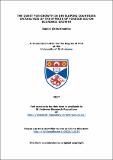Files in this item
The quest for growth in developing countries : an analysis of the effects of foreign aid on economic growth
Item metadata
| dc.contributor.advisor | Trew, Alex | |
| dc.contributor.author | Khomba, Daniel Chris | |
| dc.coverage.spatial | xv, 273 p. | en_US |
| dc.date.accessioned | 2017-06-20T16:00:30Z | |
| dc.date.available | 2017-06-20T16:00:30Z | |
| dc.date.issued | 2017-06-23 | |
| dc.identifier.uri | https://hdl.handle.net/10023/11034 | |
| dc.description.abstract | Large quantities of foreign development assistance continue to flow to many developing countries. At the same time, most of the aid-receiving countries have stagnated and become even more aid-dependent. This grim reality provokes vigorous debate on the effectiveness of aid. Despite the voluminous research on aid effectiveness, clear evidence to support the view that development aid stimulates economic growth remains scant. This thesis intends to extend the existing literature on foreign aid and economic growth. First we re-examine results from cross-country studies to provide new insights on the lack of robustness of results from this approach. We further explore and deepen the observation that cross-country results are fragile, particularly when the number of countries in the sample changes. Secondly, we study the impact of district-level aid disbursement on the growth of average night-time light density in Malawi. We use two plausibly exogenous determinants of within-country aid allocation to isolate the causal effects of aid. The results show a robust and quantitatively significant effect of aid flows in stimulating growth of light density. We find a hump-shaped growth response over three years. Finally, the thesis presents a theoretical model that explores how aid affects economic growth and welfare in an economy with subsistence constraints. The main results from this analysis are; (i) productive aid has higher long run growth and welfare effects than pure aid (ii) the rate of convergence depends crucially on how close the initial conditions are to the subsistence level (iii) while growth effects are maximised when all the aid is allocated to productive aid, we find that optimal welfare is reached when some proportion of aid is also allocated to pure transfers. | en_US |
| dc.language.iso | en | en_US |
| dc.publisher | University of St Andrews | |
| dc.subject | Foreign aid | en_US |
| dc.subject | Economic growth | en_US |
| dc.subject | Economic development | en_US |
| dc.subject.lcc | HC60.K57 | |
| dc.title | The quest for growth in developing countries : an analysis of the effects of foreign aid on economic growth | en_US |
| dc.type | Thesis | en_US |
| dc.contributor.sponsor | University of St Andrews | en_US |
| dc.type.qualificationlevel | Doctoral | en_US |
| dc.type.qualificationname | PhD Doctor of Philosophy | en_US |
| dc.publisher.institution | The University of St Andrews | en_US |
This item appears in the following Collection(s)
Items in the St Andrews Research Repository are protected by copyright, with all rights reserved, unless otherwise indicated.

